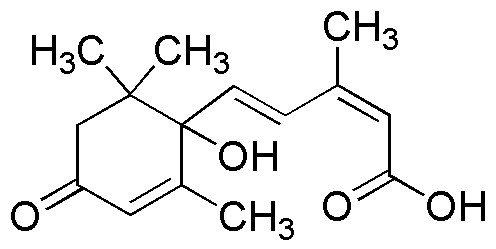(±)-Abscisic acid is widely utilized in research focused on:
- Plant Stress Response: This compound plays a crucial role in helping plants manage stress conditions such as drought and salinity. Researchers use it to study how plants adapt to environmental challenges, which can lead to the development of more resilient crop varieties.
- Agricultural Enhancements: In agriculture, it is applied to improve seed germination and enhance fruit ripening. Farmers and agronomists utilize it to optimize crop yields and improve quality, particularly in fruit and vegetable production.
- Pharmaceutical Research: Its potential therapeutic effects are being explored in medicine, particularly for conditions related to inflammation and metabolic disorders. This opens avenues for developing new treatments that leverage its natural properties.
- Biotechnology: In biotechnology, it is used to manipulate plant growth and development in genetically modified organisms (GMOs). This application helps in creating plants with desirable traits, such as increased resistance to pests or improved nutritional content.
- Environmental Studies: It is also significant in ecological research, where it helps scientists understand plant interactions with their environment. This knowledge is vital for conservation efforts and sustainable land management practices.
Información general
Propiedades
Seguridad y normativas
Aplicaciones
(±)-Abscisic acid is widely utilized in research focused on:
- Plant Stress Response: This compound plays a crucial role in helping plants manage stress conditions such as drought and salinity. Researchers use it to study how plants adapt to environmental challenges, which can lead to the development of more resilient crop varieties.
- Agricultural Enhancements: In agriculture, it is applied to improve seed germination and enhance fruit ripening. Farmers and agronomists utilize it to optimize crop yields and improve quality, particularly in fruit and vegetable production.
- Pharmaceutical Research: Its potential therapeutic effects are being explored in medicine, particularly for conditions related to inflammation and metabolic disorders. This opens avenues for developing new treatments that leverage its natural properties.
- Biotechnology: In biotechnology, it is used to manipulate plant growth and development in genetically modified organisms (GMOs). This application helps in creating plants with desirable traits, such as increased resistance to pests or improved nutritional content.
- Environmental Studies: It is also significant in ecological research, where it helps scientists understand plant interactions with their environment. This knowledge is vital for conservation efforts and sustainable land management practices.
Documentos
Hojas de datos de seguridad (HDS)
La SDS proporciona información de seguridad completa sobre la manipulación, el almacenamiento y la eliminación del producto.
Especificación del producto (PS)
La PS proporciona un desglose completo de las propiedades del producto, incluida la composición química, el estado físico, la pureza y los requisitos de almacenamiento. También detalla los rangos de calidad aceptables y las aplicaciones previstas del producto.
Certificados de análisis (COA)
Busque certificados de análisis (COA) ingresando el número de lote del producto. Los números de lote y de partida se pueden encontrar en la etiqueta de un producto después de las palabras "Lote" o "Lote".
Número de catálogo
Número de lote/lote
Certificados de origen (COO)
Este certificado de origen confirma el país en el que se fabricó el producto y también detalla los materiales y componentes utilizados en él y si se deriva de fuentes naturales, sintéticas u otras fuentes específicas. Este certificado puede ser necesario para cumplir con las normativas aduaneras, comerciales y regulatorias.
Número de catálogo
Número de lote/lote
Hojas de datos de seguridad (HDS)
La SDS proporciona información de seguridad completa sobre la manipulación, el almacenamiento y la eliminación del producto.
DownloadEspecificación del producto (PS)
La PS proporciona un desglose completo de las propiedades del producto, incluida la composición química, el estado físico, la pureza y los requisitos de almacenamiento. También detalla los rangos de calidad aceptables y las aplicaciones previstas del producto.
DownloadCertificados de análisis (COA)
Busque certificados de análisis (COA) ingresando el número de lote del producto. Los números de lote y de partida se pueden encontrar en la etiqueta de un producto después de las palabras "Lote" o "Lote".
Número de catálogo
Número de lote/lote
Certificados de origen (COO)
Este certificado de origen confirma el país en el que se fabricó el producto y también detalla los materiales y componentes utilizados en él y si se deriva de fuentes naturales, sintéticas u otras fuentes específicas. Este certificado puede ser necesario para cumplir con las normativas aduaneras, comerciales y regulatorias.


